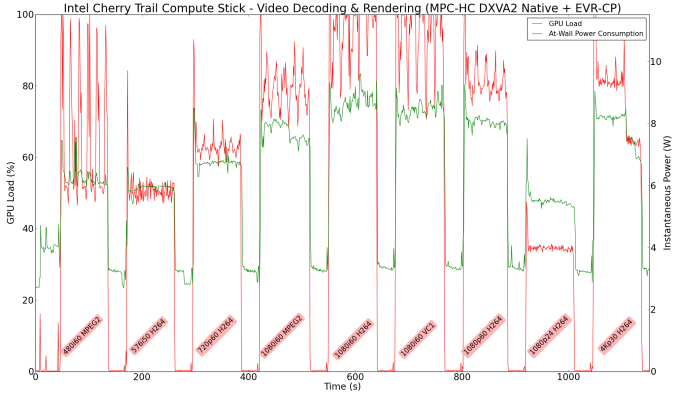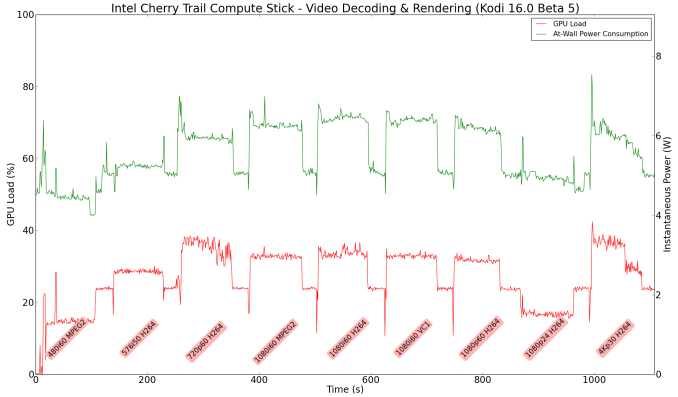The Intel Compute Stick (Cherry Trail) Review
by Ganesh T S on January 14, 2016 8:00 AM EST- Posted in
- Systems
- Intel
- Cherry Trail
- HDMI Stick
- CES 2016
- Compute Stick
HTPC Credentials
Usage of the Compute Stick as an entertainment platform is promoted by Intel as one of the use-cases. It is a bit surprising (given the form factor) that the Compute Stick has a fan. In this aspect, the Cherry Trail unit is no different from the Bay Trail unit. Subjectively, I was not comfortable with the acoustics in a 'office scenario' with the Compute Stick at the base of the monitor (connected via the HDMI extender cable) and myself seated around 70 cms. from it. The small diameter of the fan makes for a whining high-pitched noise, and it is compounded by the fact that it starts and stops depending on the SoC load.
Objectively speaking, Intel provided an acoustics rating of 28 dB at 1m distance for the noisiest mode. If the Compute Stick were to be hidden behind the TV, it is unlikely that users can hear such low noise at typical television viewing distances. It is not ideal, but Intel indicated that the performance of the device needs proper thermals. In order to to balance the very small size along with overall cost and performance, they decided to retain a small fan as the optimal thermal solution. Now that we have got the acoustics out of the way, let us move on to the other HTPC aspects.
Refresh Rate Accurancy
Starting with Haswell, Intel, AMD and NVIDIA have been on par with respect to display refresh rate accuracy. The most important refresh rate for videophiles is obviously 23.976 Hz (the 23 Hz setting). As expected, the Intel PPSTK1AW32SC has no trouble with refreshing the display appropriately in this setting. It actually performs better than the Bay Trail unit in this respect.
The gallery below presents some of the other refresh rates that we tested out. The first statistic in madVR's OSD indicates the display refresh rate.
Network Streaming Efficiency
Evaluation of OTT playback efficiency was done by playing back our standard YouTube test stream and five minutes from our standard Netflix test title. Using HTML5, the YouTube stream plays back a 720p encoding. Since YouTube now defaults to HTML5 for video playback, we have stopped evaluating Adobe Flash acceleration. Note that only NVIDIA exposes GPU and VPU loads separately. Both Intel and AMD bundle the decoder load along with the GPU load. The following two graphs show the power consumption at the wall for playback of the HTML5 stream in Mozilla Firefox (v 43.0.4).

GPU load was around 37.44% for the YouTube HTML5 stream and 11.14% for the steady state 6 Mbps Netflix streaming case.
Netflix streaming evaluation was done using the Windows 10 Netflix app. Manual stream selection is available (Ctrl-Alt-Shift-S) and debug information / statistics can also be viewed (Ctrl-Alt-Shift-D). Statistics collected for the YouTube streaming experiment were also collected here. While YouTube was more power efficient on the Cherry Trail Compute Stick, the Netflix case is the other way round. However, the numbers taken standalone do point to the Compute Stick units being a very power efficient platform for OTT streaming.

Decoding and Rendering Benchmarks
The form factor of the Compute Stick and the internal components make it clear that consumers are not going to play back videos using the madVR renderer. Instead, it is highly likely that Kodi will be used as the interface for media playback. We evaluated performance under MPC-HC + EVR-CP and Kodi 16.0 (Beta 5) for our test suite. Prior to those results, let us take a look at the codecs that are hardware-accelerated by the Cherry Trail SoC.
As expected, we have acceleration for MPEG-2, VC1, WMV9 and H.264. Interestingly, we also have support for HEVC (8-bit) and VP9 hardware-accelerated decoding in the upgraded GPU.
In our earlier reviews, we focused on presenting the GPU loading and power consumption at the wall in a table (with problematic streams in bold). Starting with the Broadwell NUC review, we decided to represent the GPU load and power consumption in a graph with dual Y-axes. Nine different test streams of 90 seconds each were played back with a gap of 30 seconds between each of them. The characteristics of each stream are annotated at the bottom of the graph. Note that the GPU usage is graphed in red and needs to be considered against the left axis, while the at-wall power consumption is graphed in green and needs to be considered against the right axis.
Frame drops are evident whenever the GPU load consistently stays above the 85 - 90% mark. In addition to tracking that aspect in the graphs below, we also get an idea of the system's power efficiency for decode and playback of some common codecs.
The above graph suggests that the Compute Stick is likely to drop frames when deinterlacing of high frame rate content is required. It is possible that EVR, the native renderer, will perform better than EVR-CP.
Kodi doesn't deinterlace content by default - so, the GPU load never goes unreasonably high. In the Bay Trail Compute Stick, Kodi struggled with the 1080i60 streams. Another aspect to observe with Kodi is that 'idling' at the XBMC interface consumes around 25% of the GPU resources and the power penalty is around 5 W. Depending on the codec and frame rate, the GPU load and power consumption might be lower or higher than the 'idle' state. For example, 480i60 and 1080p24 videos play back within the 5 W power envelop.
Note on HD Audio Bitstreaming
As of January 2016, the Intel graphics drivers for Cherry Trail (32-bit) have support only for bitstreaming of DTS, Dolby Digital and Dolby Digital Plus. This means that Netflix and other similar OTT sites are in the clear. However, users hoping to take advantage of lossless HD audio in Blu-ray backups are going to be disappointed. However, given the other limitations of the form factor and the system, it is unlikely that the absence of HD audio bitstreaming will bother too many consumers.




















80 Comments
View All Comments
AmdInside - Friday, January 15, 2016 - link
Can you comment how well it works as a Minecraft vanilla server? I picked up a Liva before and it kept crashing on Windows and Ubuntu for some reason so had to return it but wanted to buy something similar againPragmaticPraxis - Saturday, January 16, 2016 - link
Does anyone have any experience with using a Compute Stick headless, using Remote Desktop? Do you need some sort of HDMI dongle?I ask because I see a use for me as a light weight FlexLM license server for a traveling computer lab environment. But I would want to simply plug it in to power and be done. if I need to have it connected to K, V & M then a cheap Windows tablet starts looking more attractive, at least when it comes to travel.
jasperjones - Sunday, January 17, 2016 - link
I used to visit Anandtech all the time. Now I rarely come here. Here's the reason: I think this review has little relevance for real life.Instead of what you're doing, I would compare this device with:
- RPi 2
- Apple TV
- Nexus Player
- Amazon Fire TV
Also, I would comment on Linux performance. Seriously, 2GB RAM and Windows??
andrewaggb - Monday, January 18, 2016 - link
I somewhat agree. The review is about the technical details, but some actual use cases would be nice as well. I'm actually somewhat interested in the cheap version (32gb, 2gb, atom) but I'd like to know that it can handle my use cases.How does itunes and movies/shows/audio from itunes work on it (versus say an apple tv). I'm a
big fan of the new apple tv, but it cost me more than the compute stick and does a lot less.
If I use it as a steam link to stream a game from a more powerful pc, how well does it work?
Does XBMC or a similar front end work well.
Can you install linux on it, boot from usb (with legacy bios), etc?
mkozakewich - Sunday, January 17, 2016 - link
These are basically the same thing as equivalent tablets, except without the screen. I'd take a Chuwi Vi8 instead.yon1000 - Monday, January 18, 2016 - link
I truly don't understand the Price of the compute sticks - 150$+Windows Tablets cost as low as 100$ with the same processor and RAM these tablets have. and they add an HD display, a battery, Bluetooth and other hardware stuff, and above all they come with Windows 10 Installed and 1 year license of Office 365.
So how come the compute sticks cost 50% more compared to Windows Tablets?
piasabird - Monday, January 18, 2016 - link
I consider a compute stick to be a toy. Windows will not work on it well. If it came with some kind of Linux like a tablet has it might be comparable to a tablet, but not a desktop. It is just a toy.velanapontinha - Monday, January 18, 2016 - link
Ads are on overdrive on this website! Seriously, a giant ad for something related to National Geographic and an enormous "find a mexican lady" youporn-like photo is NOT the way to keep this site a respected one. Please stop this. Income is not everything, Purch!074geodude - Monday, January 18, 2016 - link
My ad blocker only showed two blocked ads, that's actually really good. I've seen many sites that are a lot worst, some with 30+ blocked ads.BurntMyBacon - Monday, January 18, 2016 - link
Can we get a mainstream build for comparison just to see how far these miniature systems have come? It would also be a good comparison to show where these systems might be sub par. You could break out a separate section of the article or even a whole separate article on the state of miniature computing. This will be especially interesting when the Core-M sticks arrive.